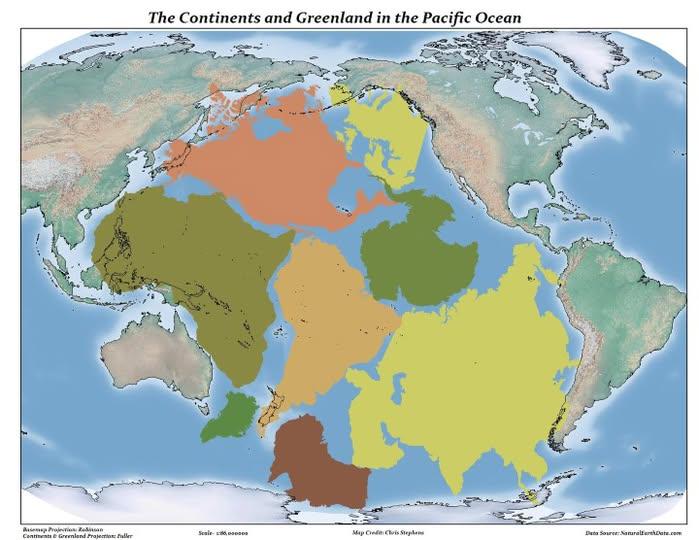Pacific Ocean Size Compared to Land Map


Alex Cartwright
Senior Cartographer & GIS Specialist
Alex Cartwright is a renowned cartographer and geographic information systems specialist with over 15 years of experience in spatial analysis and data...
Geographic Analysis
What This Map Shows
This map illustrates a staggering comparison: the Pacific Ocean is larger than all the land on Earth combined. Covering an area of about 63 million square miles, it constitutes more than one-third of the Earth's surface. The visualization emphasizes not only the vastness of this ocean but also serves as a reminder of the significant role oceans play in our planet's ecosystem and geography. Now, let’s dive deeper into the topic of oceanic size and its implications.
Deep Dive into Ocean Size
The Pacific Ocean, often referred to as the world's largest ocean, is a fascinating subject of study. It extends from the Arctic Ocean in the north to the Southern Ocean in the south and is bordered by Asia and Australia to the west, and the Americas to the east. But what does it mean for this ocean to be larger than all land?
First, let’s consider its sheer size. The Pacific Ocean covers more ground than all the continents combined, which include Asia, Africa, North America, South America, Antarctica, Europe, and Australia. This immense body of water is not merely a vast stretch of blue; it plays a crucial role in regulating the Earth’s climate. The ocean absorbs vast amounts of solar energy, influences weather patterns, and helps to distribute heat around the globe.
Interestingly, the Pacific Ocean is also home to some of the deepest points on the planet, including the Mariana Trench, which plunges down to about 36,000 feet. This depth adds to the ocean's volume and complexity. Scientists estimate that the Pacific contains more than half of the world's oceanic water, making it a vital component of Earth's hydrosphere.
Moreover, the Pacific is rich in biodiversity. Coral reefs, which thrive in its warm waters, are home to an array of marine life, including thousands of species of fish, mollusks, and crustaceans. This biodiversity is not only crucial for ecological balance but also supports the livelihoods of millions of people who depend on fishing and tourism.
Regional Analysis
When we break down the Pacific Ocean into its various regions, we can see significant differences in characteristics and impacts. For example, the western Pacific, which includes the Philippines, Japan, and China, is known for its intense typhoons and earthquake activity due to the tectonic plates converging in this area. The eastern Pacific, on the other hand, is more stable, with fewer natural disasters, but it is still affected by phenomena such as El Niño, which can disrupt weather patterns globally.
In the Central Pacific, islands like Hawaii stand out. They are formed from volcanic activity and are crucial for understanding the geology of the Pacific region. The ocean's currents and the movement of tectonic plates have shaped these islands over millions of years, creating unique ecosystems.
Furthermore, the Pacific Ocean's size and location have geopolitical implications. It serves as a major shipping lane for global trade, connecting Asia to the Americas. Countries bordering the Pacific, such as the United States, China, and Australia, have vested interests in maintaining access to its waters for economic reasons.
Significance and Impact
Understanding the size of the Pacific Ocean relative to land is crucial for several reasons. Firstly, it highlights the need for marine conservation. As we face challenges such as climate change, pollution, and overfishing, the ocean's health is directly linked to our survival. Protecting marine ecosystems not only preserves biodiversity but also ensures the stability of weather patterns and climate regulation.
Moreover, as the world continues to face issues like rising sea levels, the significance of the Pacific Ocean becomes even more pronounced. Coastal communities are increasingly vulnerable to flooding and erosion, prompting discussions about sustainability and climate resilience.
Looking ahead, it’s crucial to address these challenges. With ongoing research into ocean health and climate science, there is a growing recognition of the Pacific Ocean's role in our future. Have you ever considered how the vastness of our oceans impacts everything from local economies to global weather patterns? The size of the Pacific may dwarf our landmasses, but its influence is felt in every corner of our lives.
In conclusion, the Pacific Ocean is not just a geographical feature; it is an integral part of our planet's system. Understanding its size compared to land helps us appreciate its importance and the need to protect it for future generations.
Visualization Details
- Published
- October 24, 2025
- Views
- 46
Comments
Loading comments...